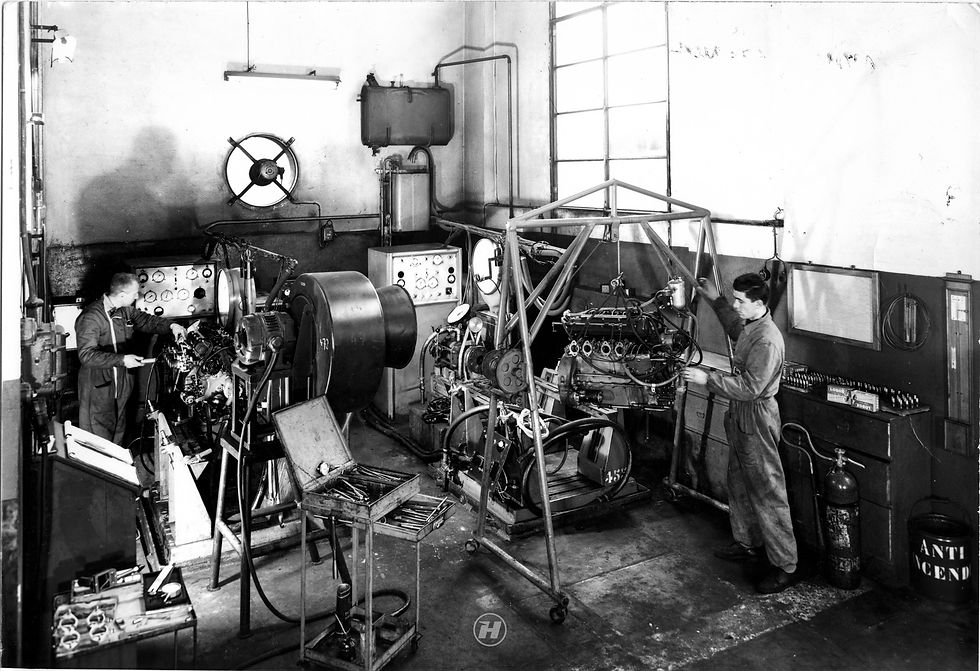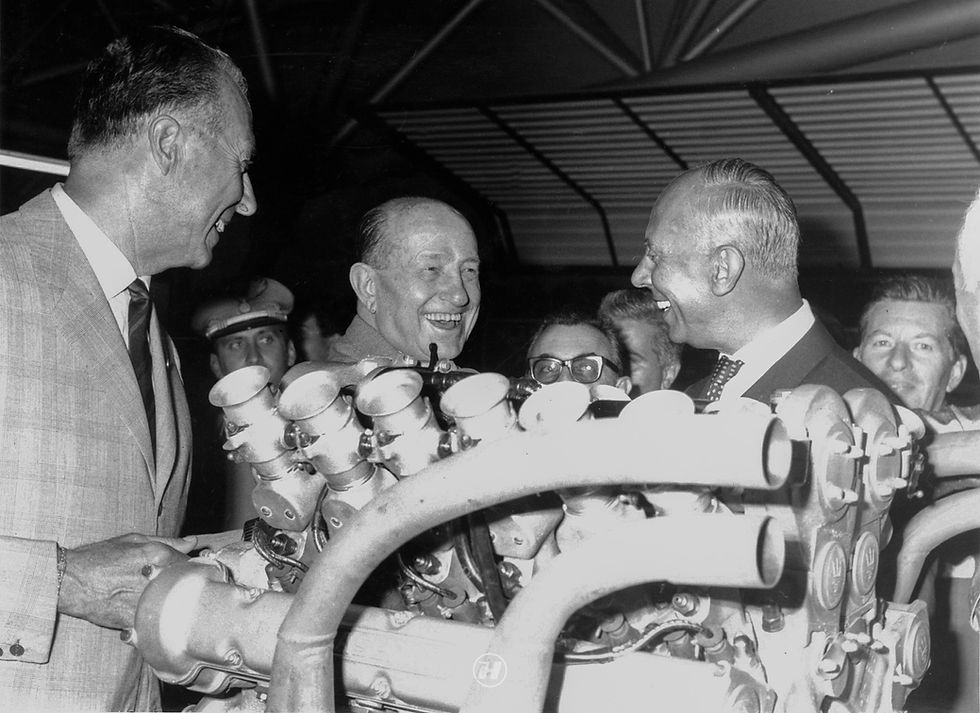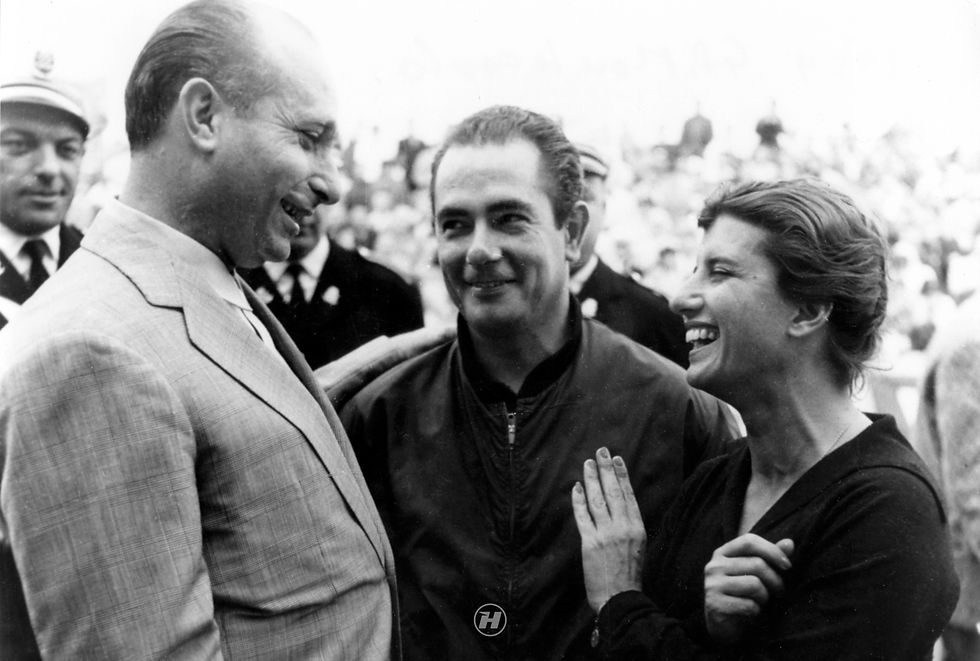Ermanno Cozza, a Neverending Story
- Alessandro Giudice

- Jun 26, 2025
- 15 min read
Updated: Oct 4, 2025
A bond born from an adolescent passion. For Ermanno Cozza, Maserati means more than just a job. For sixty years, it has represented the driver of creativity, the pleasure of relations and a technological adventure that today has become a commitment to passing on facts and traditions. A demonstration of absolute loyalty to a brand that represents the excellent style, performance and sporting flair of Italian car manufacturing
Words Alessandro Giudice
Photography Alessandro Barteletti
Video Andrea Ruggeri
Archive Courtesy of Maserati Archive

Ermanno Cozza was born in 1933, and has spent 60 years of his life in a magical bubble of creativity, quality, genius and above all people. Some of the episodes in his story may seem simple, yet in fact they reveal all the thrills and tensions behind a four-wheel legend that, with the same aplomb, has won many a victory on the track and captured the hearts of enthusiasts on the road. A long and sometimes winding road, which began with three resourceful brothers from Bologna and continued with the enterprise of a man from Modena. All driven by the desire to offer an excellent product with innovative solutions, based on the dedication, passion and sacrifice of the people who lived the adventure on the front line. People like Ermanno Cozza, who has kept every moment he spent at Maserati like a precious gem, a memory that comes across as emotional even more than historical, from where the value of the individuals who created the “Trident” magic clearly emerges.
Ermanno Cozza fell in love with Maserati because of Alfa Romeos, a Guzzi motorbike and a football, precisely in that order. The Alfas were the ones that Enzo Ferrari raced with his team, close to where Ermanno, aged 9, would pass by when going from his home in Collegarola, a small hamlet on the outskirts of town, to visit his aunts who ran a grocers shop near Vignola, outside the city, and to his uncle Achille’s restaurant, in Via Usiglio on the corner of Via Ciro Menotti. When he went home in the afternoon, he would fiddle about with the Moto Guzzi that belonged to Vito, a boy who lived in the same building: “I wanted to take it apart and hide it from the Nazis, who at the time were requisitioning anything that had an engine, and he was very fond of that motorbike,” Cozza recalls. It was then that, unscrewing a bolt, removing a part, handling connecting rods and pistons and discovering the secrets of the engine, that the young Ermanno developed a passion for all things mechanical that was to stay with him throughout his life. And the Alfa Romeos? Well, here a friend of his comes into the picture: older and skilled with engines, he had Ermanno's full attention, even when he dismissed the red cars he saw every day along Via Trento e Trieste in just a few words: “He said: ‘Nah, those are made in Milan, not here. If you want to see a real racing car you have to go down to Via Ciro Menotti, just before the level crossing. That’s where the “Fratelli Maserati” are, they’re from Bologna, they do everything themselves.

They don’t have any engineers, they do the drawings, the designs and then they build the racing cars themselves, from the engine to the bodywork, with a few of the mechanical parts coming from a factory in Porretta Terme. They won a really important race in the United States [ed.: the 1939 Indianapolis 500]’. That was when the name Maserati got into my head and never left.” A name that wasn't new to Ermanno, because it was written on the triporteurs and electric vans that he saw around the province, delivering materials and machine tools: “They had huge batteries, not like the ones we have today, they could run for 50-60 km but solved the problem of petrol and diesel shortages.”
Then one day, while he was playing football on a field near home, he saw a group of people chatting together, and one of his friends said that the guy with the hat was ‘Commendatore” (“Commander”) Orsi, the boss of Maserati, that he had moved from Bologna to Modena.
Ermanno was impressed, and when the ball rolled in their direction he (a rather timid introvert) picked up the courage to introduce himself to the gentleman: “I told him that one day I would like to work at Maserati and he asked me who I was and what I did: ‘When you finish school, come and see me and we’ll see what we can do’. And that’s what I did,” Cozza remembers with a smile half-way between satisfaction and nostalgia. Because in the meantime Ermanno continued to cultivate his passion for mechanics at the Corni Technical Institute, a veritable institution in Modena that trained the best mechanics in the area that went on to be known as Motor Valley: “It was a kind of university, set up by an industrial magnate from Modena who needed workers for his company, but was surrounded by a community of farmers.” But the year of his diploma did not end well, and Ermanno was forced to resit the exam in September (“In Italian too, because we only spoke dialect and so it was hard to speak proper Italian and impossible to write it”).

Fortunately though, he passed the exam in September and, diploma in his pocket, Ermanno headed straight for Maserati, in Via Ciro Menotti 322, on his way home. He demanded to speak to the “Commendatore”, but the porter said he wasn’t in, and they got into a heated discussion when, by pure chance, right at that moment Adolfo Orsi came through the gatehouse and asked what was going on.
When Ermanno explained who he was, Orsi told him to make an application through the correct channels and then he would look into it. And so it was. 28 October 1951, his first day at work, marked the start of one of the longest, varied and in some respects legendary careers in the history of Maserati.
A career that began in the Control Centre, where he had to check the quality of the parts produced, and then moved on to the tooling room, from where he was picked by the engineer Bellentani to work in the “esperienze” department. “There were two of Maserati's most skilled engineers, Leoni and Reggiani, who everyone called “the doctor” because he had a habit of resting a screwdriver on the running engine and putting his ear to the handle, listening as if it was a stethoscope. He was really good, and after a few years working for Ferrari in Maranello, and in America for the importer Chinetti, he came back home after an accident that kept him in bed for two months, when he discovered that he wasn’t insured by the company. So he sent them to hell and went to work for Maserati.” And it is precisely Antonio Reggiani, AKA Tonino, born in 1913, who Cozza was most fond of and who he misses the most: “He treated me like a son, he taught me everything. And if I came up with something he would always give me the merit, even though he was my superior.”

The relations between Ferrari and Maserati were quite chilly, although they had a tacit agreement not to steal each other’s top men. Just think that the back of the house where the Orsi family lived in Via Sabatini looked over the courtyard of the Ferrari factory, and both Adolfo Orsi and Enzo Ferrari often took their drivers to eat at the Cantoni restaurant nearby: “There was never more than a nod of the head when they met. When Ferrari wanted to know what was new at Maserati, he didn’t even say its name: ‘What are they up to down there?’ he would ask. There was respect, but also a kind of love/hate relationship.” One thing that became part of Cozza’s DNA is that he too has trouble calling Enzo Ferrari by name, instead using the more distant and generic “the one from Maranello”.

Even though he spent most of his time working on competition cars, he hardly ever went to the races. In 1953: “That year I even worked on Christmas Day. The cars had been shipped to Argentina in late October for the Temporada. They were the old F2s, the new ones were being completed. But we had a technical innovation that needed to be designed and tested.” This was the De Dion suspension, which had the differential joined to the gearbox. Valerio Colotti, a designer who had come to Maserati after working for Ferrari, had begun to design it in September after the head of the Maserati esperienze department, Vittorio Bellentani, had sent him to Monza to “watch” the Mercedes track tests, and see how the rear of the German car was made.
Cozza recalls: “The Autodromo director, Giuseppe Bacciagaluppi, got him some Pirelli overalls so that he would blend in and not be noticed.” Right after the Mercedes went off the road, replacing a rear wheel one of the mechanics covered the tail of the car, but not quickly enough to prevent Colotti from taking a mental photo of what he had seen, the De Dion suspension, which he then did even better, turning it into a masterpiece. And so on 25 December 1953 they decided on the engine to be used by Fangio, and the following day, Boxing Day, in the winter fog and a temperature of just 2 or 3 °C, the test driver Guerino Bertocchi tested the 250 F with a new engine and the De Dion suspension at the “Aeroautodromo” in Modena.
“After a few laps of the track, he stopped, took off his gloves, pulled off his goggles and said to us, all hanging on his words: ‘Now that’s what I call a real car!’. The following day we all went to Malpensa to load the cars on the plane for Buenos Aires.”
This was just the first stage of a mission that was heading for perfection, and not only in sporting terms. Indeed, while the team and the drivers Fangio and Marimón were showing the cars to General Perón, who knew Italy well having attended the Military Academy in Modena, Commendator Orsi signed an agreement with some manufacturers to supply 50 machine tools made by one of the factories owned by his family. On the day of the Grand Prix, Sunday 17 January, with the Ferraris in pole position on the starting line and for much of the race, the weather was what actually helped the Maserati 250 F, “considered by the sports press to be an evergreen car.” Its engine, developed in the close-to-zero temperatures of the Po Valley and running at over 40 degrees in South America, in the pouring rain that cooled the air an hour into the race, began to work at full power, and Juan Manuel Fangio shot off into the lead, with the single-seater winning its début race. The result was repeated during the first European race of the season, on the Belgian circuit at Spa-Francochamps, before the Argentine driver moved to Mercedes-Benz.

Talking about the Argentine champion, Cozza states: “Fangio was a mechanic, a guy who knew his cars. He was also a saver, and never pushed the engine to the max. When we offered him an injection engine for the 250 F, he said he preferred to carburettor version, even though it developed around twenty HP less: ‘I’ll get them out of her, don't you worry’. He was a lovely person, really pleasant but terribly suspicious: when he tested a car, he always wanted someone to be there to make sure that nobody could get close. Those were the days when the driver counted for 51-52% of the success, but gradually cars have taken over in percentage terms. Who were the best drivers at that time? Nuvolari, Fangio, Surtees, Jim Clark.”
The trip to South America would have been perfect, had it not been for the fact that after the dozens of machine tools under Orsi’s agreement were delivered, a military coup overthrew President Peron and the supply was never paid for by the industrial companies but only through wheat supplies sent by the Argentine government to the Italian government, which then gave the equivalent in cash to Maserati only five years later, in 1959.
The matter put the company into receivership: “I remember that when we began to make the 3500, we bought ZF gearboxes from Germany, and the orders were signed and the payments authorised by an official at the bank. This was a humiliation for Commendator Orsi, who sold off his personal property to close the procedure in six months,” Cozza explains.
But it was also the time when they had to disband the Racing Department: “Called in by Orsi, all the staff confirmed their willingness to work without pay until the matter had been resolved: ‘You will pay us when you can,’ said Brancolini, an engineer who spoke on behalf of everyone. With tears in his eyes, Orsi replied that he had found other positions for all of them: ‘Two to Ferrari, one to Centro Sud, one set up his own business and another went to Weber’.”

1963 saw the birth of one of the Trident's most extraordinary and iconic cars, the Quattroporte, which was an obsession for Orsi who couldn’t believe that his business colleagues bought Mercedes, Jaguars or even Rolls-Royces.
“It was the car for Italian and European businessmen, and I had to solve a big problem,” Cozza continues. It all came about when the engineer Alfieri received a phone call from the Swiss dealer Sonvico: one of his clients in Lausanne had complained that on the kilometre of cobbles leading up to his house, sitting the rear seats of the Quattroporte - the third one to be delivered - you couldn’t talk or hear anything because of the noise made by the suspensions. “The engineer called me and said ‘get a sound meter and tell me where I can find a dirt track near the factory’, and I took him to one near Vignola that seemed like a dump site. The values recorded were really high, too high for a luxury sedan.” It was a technical problem, the shock absorbers sent the wheel vibrations to the bodywork which was in steel sheet and not tubular.
“One evening Orsi came by and saw me working on a Quattroporte, and asked, ‘Well?’ and I replied ‘We can't solve this one, commendatore. And just think, two thousand years ago the Romans had chariots with leaf springs’. It was a moment of enlightenment, and the next day we mounted these on the rest of the production.”


On his many business trips, in 1968 Orsi also met the chairman of Citroën, who asked him for an aluminium six-cylinder engine for a future four-seater gran turismo coupé because, he said, ‘our engines are too heavy and cumbersome’: “When the commendator told us, Alfieri and I had the same idea. We made the engine from an eight-cylinder, cutting two of them off to make a special 6-cylinder with a 90-degree V cut. A compact engine designed for front-wheel drive, to be assembled with the gearbox.” Meanwhile, the Michelin family, who owned Citroën at the time, was interested in buying out Maserati: “Commendator Orsi was already getting on, his son Omer was becoming ill and his sons, the engineer Roberto and the doctor Adolfo, were still just kids.” Citroën bought all the shares in 1970, but there was no particular interference: Maserati continued with its production, in addition to twenty or so C114 engines for the SM, launched in the same year. The oil crisis of 1973 put Michelin in trouble, and among the sale of many of its collateral businesses was also Maserati, which was taken over by the Italian government via GEPI, the public financial corporation set up to help companies in difficulty.
And that was when Alejandro De Tomaso, Argentine driver and businessman who had at the time of Citroën’s entry into the company tried to take Maserati into Chrysler, came back into the picture.
He bought out the first 30% of the company and took over its management, thanks to the experience gained in his own company Automobili De Tomaso: “Every year he bought another 5-10% of the GEPI stake and ended up with the full ownership of Maserati. He did the same thing with Innocenti, abandoned by British Leyland with 3000 employees, which GEPI forced him to purchase.” De Tomaso thought that he could solve the world crisis with a small car (to avoid the VAT rate of 38%) but powerful and prestigious like a luxury car: “And that’s how the Biturbo was born. In 1981 the engineer Bertocchi, son of the historical Maserati test driver, who had left to work for De Tomaso after Citroën had put a French technician in charge, returned to Maserati. One day he called me into the test room to watch the tests of the 2-litre V6 with twin-turbo. It went like a dream, a great 180 HP engine, but in the end, I asked De Tomaso, who was also there: ‘This is all fine now in October, but what will it do in the spring when the temperatures rise?’. I should have kept my mouth shut: ‘What do you mean? What do you know about engines?’ I didn't answer, but the whole production suffered from overheating, along with a number of other problems due to the rush to get it on the road.” These problems did not change De Tomaso's plans, and the production continued until 1997, even after Maserati was bought out by FIAT (1989) with many different names and versions (the last was called Ghibli), all coupés and spyders.
Alejandro De Tomaso was not an easy man to get along with: he was an authoritarian with a short temper, and he often spoke harshly even to his closest staff: “He tried with me too,” Cozza recalls, “but I went right up to him, my face just inches from his nose, and said: ‘Mr De Tomaso, my name is Cozza. If you need me, call me Cozza and do not dare to use those adjectives that you use with the others.”
One day Ermanno was called by De Tomaso who asked him about a detachable crankshaft, a design dating back to 1939 that he had found in a warehouse where Cozza had stored all the Maserati material that Citroën wasn't interested in. He was with the Swiss importer, and was boasting about the finesse of the Maserati technology. “Mr De Tomaso, we have so much of that stuff in the warehouse, it’s a shame to leave it there. He replied: ‘Well you deal with it; I’ll give you a budget to restore and catalogue it all’. The first year he gave me five million lire, the second year twice that.”

And this is where the story of the Maserati collection begins, because De Tomaso had set up a company to which he charged all the costs of restoring the cars and cataloguing the documents, so when the company was sold to FIAT, the period cars belonged to the Argentine businessman, who at one point decided to sell them at auction. Word got round in Modena, and to prevent this Italian heritage from being sold off abroad, Omer Orsi’s son, Adolfo, along with Maria Teresa de Filippis, a historical Trident driver, went to Rome to see Veltroni, who was Minister of Cultural Heritage at the time. However, his hands were tied because the whole collection was in England, as sensing the problem, De Tomaso had had it all transferred in a hurry.
And this is when one of the Panini brothers, Umberto, came into play. He had been a mechanic and test driver of Maserati motorbikes, which Adolfo Orsi’s sister had begun to build after taking over a bankrupt company from Bologna called Italmoto. After the mother, a widow with five children, had opened a newsagent in Modena, the brother Giuseppe, AKA Peppino, had the idea of the football cards.
This winning idea became a huge business, and indeed Peppino was forced to call Umberto back from Venezuela, where he had emigrated and enjoyed his own professional success. “Come home, America is here!”. He came back to Italy and invented the “Fifimatic”, a card bagging machine that sped up the process. Another great success. When they sold the publishing business to the English, Umberto opened a large agricultural holding called Hombre, where they not only make and sell organic Parmigiano-Reggiano but also have a motorbike and tractor museum, which he is passionate about. And he was also the one to be involved in purchasing the Maserati collection: “He took his Fiat 130 to Stanguellini for a service and told him about the cars from the Maserati Museum being auctioned in England. Panini seemed uninterested, but not too much. “Between a rock and a hard place”, as they say.
So Stanguellini called Orsi and together they went to see Panini who asked which cars they were: racing and road cars, Cozza did all the restorations and has all the documentation’. How much do they cost? ‘Five or six billion lire’, while his son Matteo asked his father ‘but do we really have all that money?’. ‘Don’t you worry’. And that's how the cars returned to Modena, and today, even only one of them could easily pay off the initial investment.”

While Umberto Panini’s intervention saved the tangible heritage of the Trident tradition, ensuring that it remained in Italy, it is thanks to Ermanno’s painstaking work that all the documentation concerning the cars and company events was catalogued.
Today this heritage allows the company’s Maserati Classiche division to certify the originality of the cars and the correctness of their restoration, in addition to providing assistance to collectors, historians and enthusiasts with the many archive documents.
Returning to the company history, 1997 saw the union with Ferrari, promoted by FIAT with the relaunch project assigned to Luca di Montezemolo, the Ferrari chairman, at a time which, for Cozza, was a happy and especially technological period for the Trident, above all from 2002, when the new Coupé and Spyder models were fitted with a 4.2 l V8 engine produced in Maranello. “It was a natural and absolutely spontaneous birth. It did us good to work with them, a company that shared similar traditions, history and products. If it was up to me, I would seek more partnerships between the two brands.”
But of all the dozens of models that have passed him by, which is Ermanno's favourite? “My favourite Maserati is the “Dama Bianca”. This was the 3500 GT prototype with Touring bodywork that came to Modena for the final adjustments and tuning. It was white with blue leather interiors, very elegant, a magnificent car. It came and went from the workshops, and we gave her this nickname to recognise her. When I think of a Maserati, I think of her.”
Ermanno Cozza’s precious testimonial offers a view of how things were done from the inside, with all the nuances, anecdotes and intimate moments that were decisive for the history of the Trident, a history that Maserati has written and continues to write, underlining the brand’s excellence in the racing world, in its technique and in its style. With a witness whose love for the company has never waned. “I spent 38 years working for Maserati, and 22 more as a consultant, and I still go there every Wednesday. You never know when they might need a hand.”





































Comments